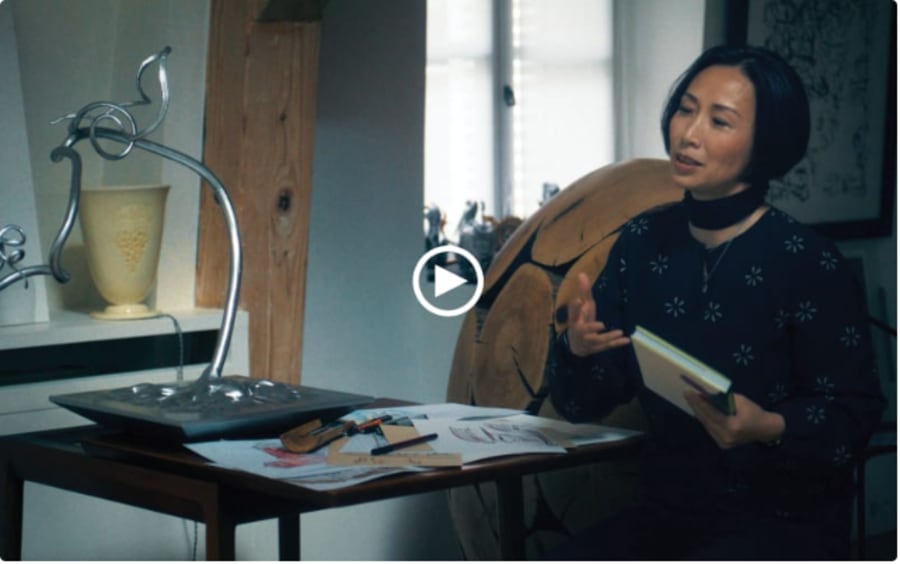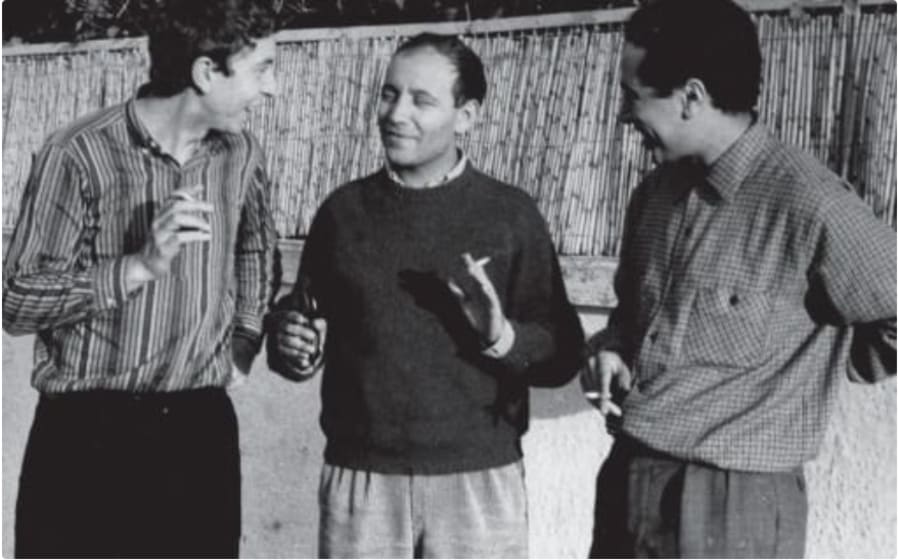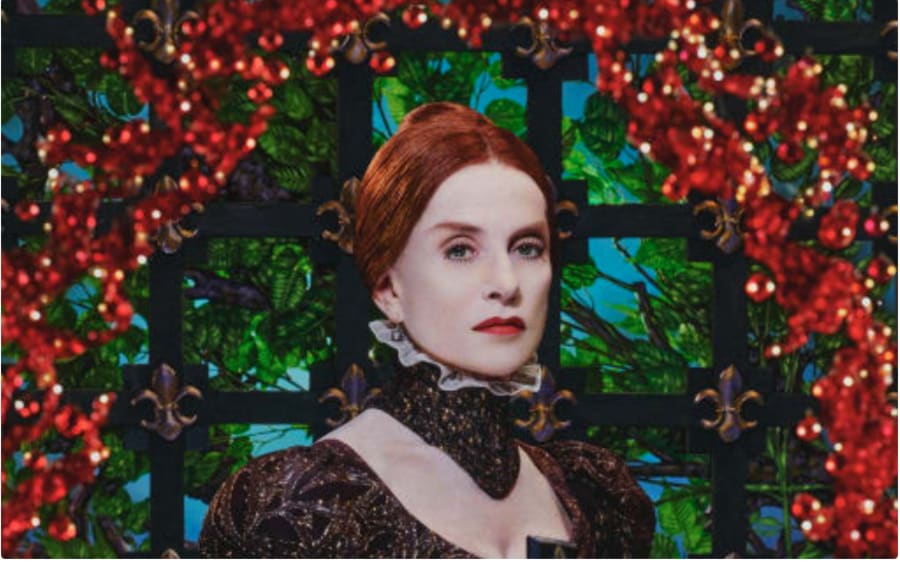Oliver Beer makes spaces sing – almost literally. Classically trained as a musician and composer, the artist taps into the little-known but omnipresent phenomenon of acoustic resonance, in which any empty space or form can be made to elicit a powerful musical note – as with rubbing a wine glass – when stimulated at the right frequency. For over a decade, Beer has teased out the resonant frequencies of locations as varied as the sewers of Brighton, southern England, and the Centre Pompidou’s glass corridors, mapping a creative terrain at the crossroads of architecture, form, and harmony.
His latest project, though, might be his most ambitious to date. For the multi-screen video and sound installation The Cave, which will premiere at the Lyon Biennial this week, the artist enlisted a star cast of musicians, including Rufus Wainwright, Woodkid, and Mélissa Laveaux. He invited them to sing their earliest musical memory and play with the resonant frequency of the Grotte de Font-de-Gaume, a Paleolithic cave in the Dordogne, southwest France, celebrated for its polychrome paintings and ancient engravings. The result is an operatic, immersive work – and an invitation to encounter sounds that might have been first experienced by cave artists up to 19,000 years ago.
For the fourth instalment of our ‘Artist As’ series – which profiles practitioners operating beyond the traditional confines of the visual arts – I asked Beer about the role music played in his artistic training, the links he draws between the sonic and the visual, and his quest to transcend Western music’s loaded legacy.
You were a precocious musician, and music was your first love long before you got into visual art. What attracted you to it in the first place?
When I was about eight years old, my sister brought home a stranger who asked to hide her Steinway in our barn as she was running from the bailiffs. My parents agreed, but the stranger then disappeared for a couple of years. I taught myself to play on this beautiful, abandoned instrument. Years later, this led me to a music scholarship at an international school, and to create a band, so that initial contact with music really took me out of my rural upbringing into the broader world. It really changed the course of my life.
I had a deep, visceral connection to sound from a young age. I was curious about music from other cultures and would search esoteric music stores for new sounds. And I vividly remember hearing melodies in everyday objects, like the resonance of empty containers or the harmonics of a passing tractor engine. Very early on, I also taught myself how to find the resonant frequency of a room and sing to the room so that it would sing back to me.
This phenomenon became absolutely central to your practice and to an ongoing series of works, ‘The Resonance Project’ [2007–]. How would you sum it up?
Form and harmony are intrinsically connected. Every empty room sings just like a wine glass, each with its unique musical note determined by its form. If you sing the right note, you create wavelengths that fit perfectly within the room’s dimensions, producing a standing wave at its resonant frequency. Suddenly, the room’s voice becomes exponentially louder than your own. The experience is astonishing, almost shamanic, as the sound emerges from the walls.
At what point did you turn this awareness of the resonant frequency into an art project?
Resonance gradually became part of my practice, first during my music degree and then during my art degree. I began ‘The Resonance Project’ in 2007, experimenting with various architectural spaces – from the Brighton sewers to an unauthorized performance I made as a student in the glass tunnels of the Pompidou Centre.
You don’t experiment with resonance just using your own voice. Very soon, you started to invite other musicians and singers to participate. For The Cave project, you gathered an incredible cast of musicians, including Rufus Wainwright, Woodkid, and Mélissa Laveaux. What was the process that pushed you to continue developing this idea?
Each architectural space is a unique instrument with its own harmonies, and the singers bring their own musical influences to each piece, so it’s never the same twice.
For about 10 years, I dreamt of making a work in the famous Paleolithic caves of the Dordogne, which contain some of humanity’s earliest artworks. I was convinced I would find a relationship between the locations of the paintings and the resonant sweet spots of the cave of Font-de-Gaume. I was granted access in 2021, and over three years I filmed a video opera there. I discovered a connection between the cave paintings and the cave’s resonance.
You thought that prehistoric people painted on the caves’ wall at specific spots because of their acoustic properties?
I suspected a connection but didn’t realize how closely it related to resonance. On my first visit to the cave, I sang and listened for a resonant sweet spot, whispering notes until they turned into a powerful standing wave. The archaeologist accompanying me could barely believe what we were hearing. It’s hard to describe the sensation of this resonant sound. It is immense, immersive, seeming to come from the walls themselves. And you also find yourself in front of concentrations of amazing paintings at exactly those spaces.
I painstakingly mapped the cave’s different frequencies and discovered a correlation between the primary resonant musical notes and the concentration of paintings. The discovery led the archaeologists I’ve been working with to question whether people may have been singing these same musical notes 19,000 years ago, which would make it the oldest harmony that we know of.
Realizing it was impossible to bring the public into the cave, I created an installation to bring the cave to the viewer. The Cave will premiere at the Lyon Biennale in a vast industrial space, with eight synchronized cinema screens and 16 speakers, recreating the experience as if we were alongside the singers inside the cave.
This project strikes me as a perfect example of something being more than the sum of its parts. And that’s where part of your talent lies – in making the different voices work together. How does this apply to The Cave project?
I led each singer individually into the cave, guiding them to perform their earliest musical memory at the acoustic sweet spots. The cave acts like a geological tuning fork, always singing the same note. So the singers are perfectly in tune with each other, even though they were never in the space together. Their melodies – from Japan, Haiti, Lebanon, Australia, France, North America, and Denmark – are brought into a cohesive polyphony by the cave’s consistent resonance.
I composed the fragments of their melodies into a counterpoint that interlocks when sung together. The result is an immersive installation that allows viewers to experience the cave’s unique acoustic environment – inhabited and transformed by these melodies – but also the emotional journey through the childhood musical memories of each singer. It’s a kind of cadavre exquis of music, where the singers’ musical memories are woven together, absorbed and transformed by the resonance of the cave.
Did the musicians’ interaction with the cave surprise you? I imagine that opening the instrument up is part of the thrill.
Yes! The composition includes fragments of the first music each singer remembers hearing – and that really changed how they interacted with the space. I interviewed them about their choices and what it meant to sing them in this ancient place. Rufus Wainwright chose À la claire fontaine, a song that his mother sang to him, and that he sang to her on her deathbed. Mélissa Laveaux’s choice was rooted in the voodoo songs of Haiti. This underscores the concept of being part of a continuous chain of musical inheritance, constantly evolving, going back to the very first human communities. This is how music evolves.
In an underground tunnel beneath the exhibition space, you’ll show a new series of your Resonance Paintings, made using sound waves to move pigments on the canvas without ever touching it. Do these new paintings relate aesthetically to the Paleolithic paintings?
Yes, my new Resonance Paintings explore sound and space but also connect to the figuration and abstraction found on the Paleolithic walls.
I make the paintings by placing a speaker beneath a horizontally positioned canvas and scattering finely powdered pigment on the surface. By playing specific musical notes that cause the canvas to vibrate, the pigment moves, forming patterns that visually represent the sound waves. I’ve learned to precisely control these waves, using sound like a paintbrush to create the forms I’m looking for. Then I fix these shapes in place, capturing the invisible shapes of sound – the physical manifestation of waveforms.
For The Cave, I made a new series of Resonance Paintings using each singer’s voice to stimulate vibrations. I incorporated the exact same black and ochre pigments found in the cave paintings. The series transitions from deep earth tones to celestial colors, echoing the musical journey experienced in the cave.
You come from the Western musical tradition, which is itself completely enmeshed with the Enlightenment project – and thus with a history of Western hegemony. It feels to me that it’s something that you’ve been attempting to undo, or at least to address, always working with an awareness of the pain and trauma that comes with this heritage.
Absolutely. The Western musical tradition is an imperial phenomenon. For example, the Western piano scale, conceived in 18th-century Germany – and epitomized by Bach’s Well-Tempered Clavier – is just one of thousands of possible scales. Yet, due to the dominance of Western music, it has become the most prevalent scale worldwide. This is a kind of empire of harmony. That’s why it’s crucial to acknowledge the specificity of the musical ideology we’ve been raised with and to engage with different musical traditions, especially when composing. It’s important to consider the cave as a space that predates all our cultures and nations. Although it’s located in France, it’s a shared space.
This idea of shared space and humanity is something that you’ve tapped into again and again. This is obvious to me in your desire to go back to something as essential as a sound frequency for instance, which is not, intrinsically, culturally specific.
There’s a tension between the universality of music and the fact that, when we create music, we express the most subjective, personal aspects of ourselves and our cultures. It’s increasingly clear to me that while I work with elements shared across every culture throughout history – like the voice, harmony, or resonance – the moment these elements are embodied by a specific musician or shaped by a composer, they become rooted in a particular time, place, culture, and politics. That tension is where their power lies.
17th Lyon Biennial of Contemporary Art
‘Crossing the water’
September 21, 2024 – January 5, 2025
Oliver Beer is represented by Thaddaeus Ropac (Salzburg, Paris, London, Seoul) and Almine Rech (New York, Shanghai, Brussels).
Coline Milliard is Art Basel’s Executive Editor.
Caption for top image: Rufus Wainwright and Oliver Beer during the shoot of Resonance Project: The Cave, 2024. © Oliver Beer. Image: Oliver Beer.
Published on September 18, 2024.


